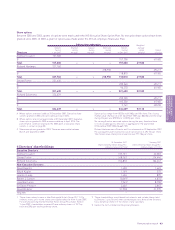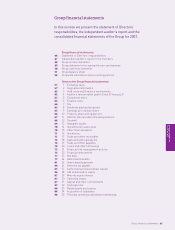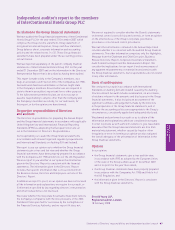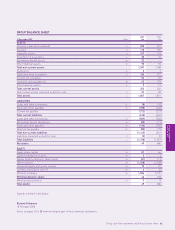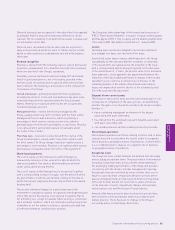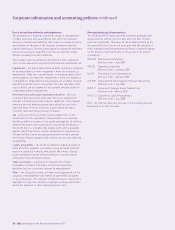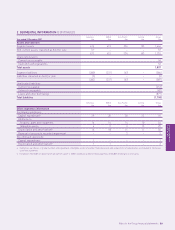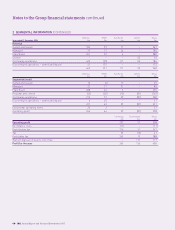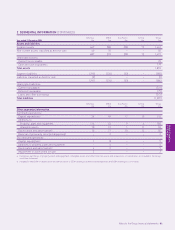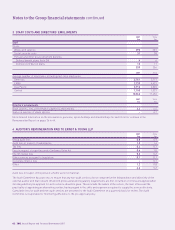Holiday Inn 2007 Annual Report Download - page 54
Download and view the complete annual report
Please find page 54 of the 2007 Holiday Inn annual report below. You can navigate through the pages in the report by either clicking on the pages listed below, or by using the keyword search tool below to find specific information within the annual report.
52 IHG Annual Report and Financial Statements 2007
Corporate information and accounting policies
Corporate information
The consolidated financial statements of InterContinental Hotels
Group PLC (the Group or IHG) for the year ended 31 December
2007 were authorised for issue in accordance with a resolution of
the Directors on 18 February 2008. InterContinental Hotels Group
PLC (the Company) is incorporated in Great Britain and registered
in England and Wales.
Summary of significant accounting policies
Basis of preparation
The consolidated financial statements are presented in sterling
and all values are rounded to the nearest million (£m) except
where otherwise indicated.
Statement of compliance
The consolidated financial statements of IHG have been prepared
in accordance with International Financial Reporting Standards
(IFRS) as adopted by the European Union and as applied in
accordance with the provisions of the Companies Act 1985.
The Group has early adopted International Financial Reporting
Interpretations Committee 14 ‘IAS 19 – The Limit on a Defined
Benefit Asset, Minimum Funding Requirements and their
Interaction’ (IFRIC 14). IFRIC 14 provides guidance on assessing
the limit in International Accounting Standard 19 ‘Employee
Benefits’ (IAS 19) on the amount of the surplus that can be
recognised as an asset. It also explains how the pension asset
or liability may be affected by a statutory or contractual minimum
funding requirement. Under IFRIC 14, the Group has recognised
retirement benefit assets of £32m on the balance sheet at
31 December 2007.
The Group has also adopted International Financial Reporting
Standard 7 ‘Financial Instruments: Disclosures’ (IFRS 7) for
the first time in these financial statements. This is a disclosure
standard only which has had no impact on the Group’s results
or net assets. The new disclosures are included throughout
the financial statements.
Other new accounting standards and interpretations issued
by the International Accounting Standards Board (IASB) and the
International Financial Reporting Interpretations Committee
(IFRIC), becoming effective during the year, have not had a
material impact on the Group’s financial statements.
The principal accounting policies of the Group are set out below.
Basis of consolidation
The Group financial statements comprise the financial statements
of the parent company and entities controlled by the Company. All
inter-company balances and transactions have been eliminated.
The results of those businesses acquired or disposed of are
consolidated for the period during which they were under the
Group’s control.
Foreign currencies
Transactions in foreign currencies are translated to the
functional currency at the exchange rates ruling on the dates of
the transactions. Monetary assets and liabilities denominated
in foreign currencies are retranslated to the functional currency
at the relevant rates of exchange ruling at the balance sheet
date. All foreign exchange differences arising on translation are
recognised in the income statement except on foreign currency
borrowings that provide a hedge against a net investment in
a foreign operation. These are taken directly to the currency
translation reserve until the disposal of the net investment, at
which time they are recycled against the gain or loss on disposal.
The assets and liabilities of foreign operations, including goodwill,
are translated into sterling at the relevant rates of exchange ruling
at the balance sheet date. The revenues and expenses of foreign
operations are translated into sterling at weighted average rates
of exchange for the period. The exchange differences arising on
the retranslation are taken directly to the currency translation
reserve. On disposal of a foreign operation, the cumulative
amount recognised in the currency translation reserve relating
to that particular foreign operation is recycled against the gain
or loss on disposal.
Derivative financial instruments and hedging
Derivatives designated as hedging instruments are accounted
for in line with the nature of the hedging arrangement. The
Group’s detailed accounting policies with respect to hedging
instruments are set out in note 21. Documentation outlining the
measurement and effectiveness of the hedging arrangement is
maintained throughout the life of the hedge relationship. Any
ineffective element of a hedge arrangement is recognised in
financial income or expense.
Interest arising from currency swap agreements is taken to
financial income or expense on a gross basis over the term of
the relevant agreements. Interest arising from other currency
derivatives and interest rate swaps is taken to financial income
or expense on a net basis over the term of the agreement.
Foreign exchange gains and losses on currency instruments are
recognised in financial income and expense unless they form
part of effective hedge relationships.
The fair value of derivatives is calculated by discounting the
expected future cash flows at prevailing interest rates.
Property, plant and equipment
Property, plant and equipment are stated at cost less depreciation
and any impairment.
Borrowing costs are not capitalised. Repairs and maintenance
costs are expensed as incurred.
Land is not depreciated. All other property, plant and equipment
are depreciated to a residual value over their estimated useful
lives, namely:
buildings – lesser of 50 years and unexpired term of lease; and
fixtures, fittings and equipment – 3 to 25 years.
All depreciation is charged on a straight-line basis. Residual value
is reassessed annually.



